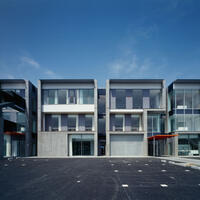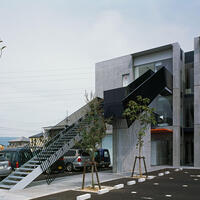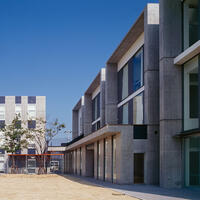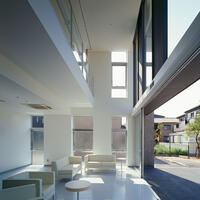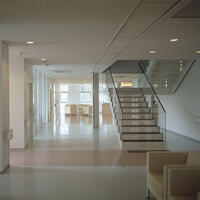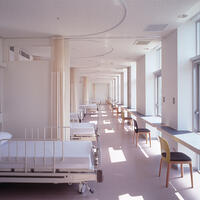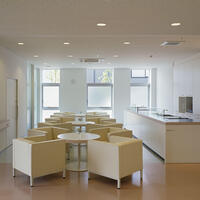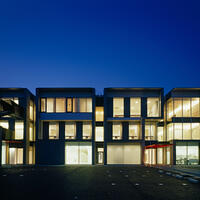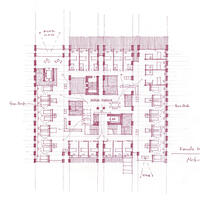Kondo Hospital
Tokushima city, Tokushima, JAPAN
| Architect | Furuya Nobuaki+NASCA |
|---|---|
| Usage | Hospital |
| Structure | RC |
| Size | 4F |
| Site area | 6.039.97㎡ |
| Area | 4,079.05㎡ |
| Completion | 2002.03 |
| Award | Architectural Institute of Japan (AIJ) Award 2004 |
| Publishing | Shinkenchiku 2002.12 |
This is a hospital for internal diseases which, owing to the widening of the prefectural road, has been moved to a site just across the street. For the first time in Tokushima Prefecture, a palliative care ward with twenty beds for terminal cancer patients was established. It is a private hospital which has fifty-five beds in total, with thirty-five beds in the general ward. We started to select the site with the director and his wife, and finally decided to choose this site after careful consideration of more than seven candidates.
As the street on the south side will be elevated in the future, the building is positioned a little northward from the street. Parking space is placed in front of the building, and various kinds of trees are planted in lines in order to provide enjoyment of spring blossom and tinted leaves in autumn. The southern and northern elevation surfaces have a shape that shows four cross sections of square tubes. You can see the inside the hospital from outside; from the inside of the hospital, on the south side, the street can be seen, and also some scenery, including the Sonose River to the north. On the right hand side toward the front is the entrance for outpatients of the general internal department, and the entrance of the palliative care ward: it is intentional that both entrances are separated loosely rather than definitively. The emergency stairs from the second and third floors stick out in front, because it is useless for emergency stairs to be hidden from daily view.
On the eastern and western elevation surfaces, the wall-type columns are placed in parallel, serving as the structure for the design.
The consulting rooms for outpatients and the inspections department are placed on the first floor, and the sickrooms on the second and the third floors. As this is an almost perfect square with a 3-layer layout, the center is quite dark, because it is farthest from the windows. The nurses’ station is located in a space connected to surrounding corridors. In order to avoid being too dark or oppressive, the corridors are constructed with light-wells and vertical flows. An anxious patient was once moved, in their bed, into the nurses' station and stayed overnight in this spacious room.
All the rooms on the third floor are private ones, and there are fifteen private rooms and shared rooms on both the east and west sides of the second floor (with ten beds on each side). We tried a new plan for the multiple beds, a “sun-deck style sickroom”, as we called it, where the patients lay themselves next to each other and all of them lay looking towards the windows. They could see their own narrow windows over their toes when they lie down on the beds, so that the room suddenly becomes personalized and the patients do not concern themselves with the other patients. From the lounge at northwest corner of the third floor, the sights of hospice garden and the sunset over the river can be enjoyed, and there is also an open kitchen where the patients and family converse. Spaces which tend to be divided according to function, are optimized so as to generate more area for the total floor space.
Photos: Matsuoka Mitsuo


















